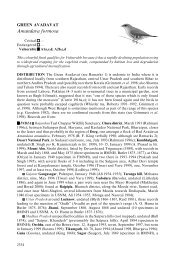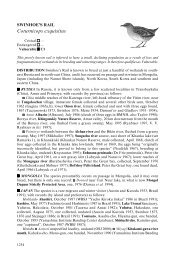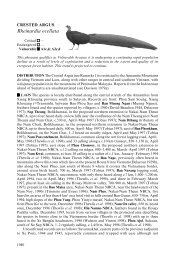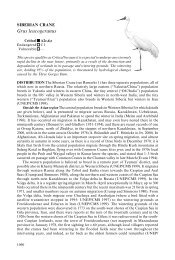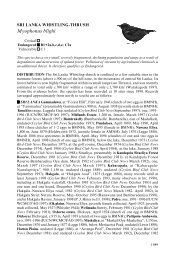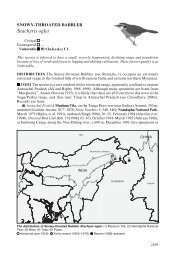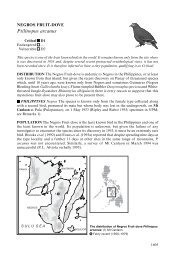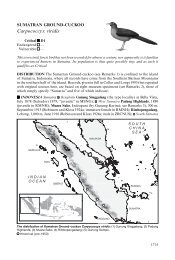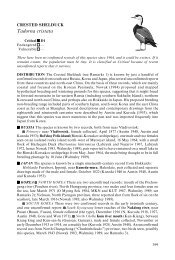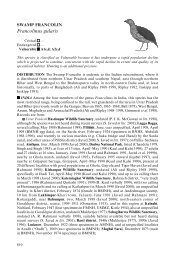You also want an ePaper? Increase the reach of your titles
YUMPU automatically turns print PDFs into web optimized ePapers that Google loves.
WHITE-SPECKLED LAUGHINGTHRUSH<strong>Garrulax</strong> <strong>bieti</strong>Critical —Endangered —Vulnerable C1; C2aThis poorly known laughingthrush qualifies as Vulnerable because it is inferred to have a small,declining, severely fragmented population as a result of destruction of temperate and subalpineforest through logging and conversion to agriculture and pasture.DISTRIBUTION The White-speckled Laughingthrush is a poorly known Chinese endemic,known from the mountains of south-west Sichuan and north-west Yunnan. Records (byprovince) are from:■ CHINA ■ Sichuan Ma Huang valley, Kangwu Liangsi, 35 km north-west of Muli, Mulicounty, seen and tape-recorded, “fairly common, but difficult to observe”, 3,100–3,200 m,April 1989, in bamboo (King 1989a); Mt Gibboh, south of Muli lamasery, Muli county,3,960–4,270 m, April 1929 (Riley 1932, female in USNM);■ Yunnan “Mekong–Salwin divide”, 3,050 m, September 1921, in mixed forests (Rothschild1923a, 1926, male and female in BMNH); Huang-fu-ping (Hofuping mountains), Mekongvalley, November 1923 (Riley 1926, specimens in AMNH, MCZ and USNM), collected atNdamucho, south of Lütien and west of the Yangtze river on the Yangtze–Mekong divide,CHINASICHUAN34512MYANMAR8910671112YUNNANThe distribution of White-speckled Laughingthrush <strong>Garrulax</strong> <strong>bieti</strong>: (1) Ma Huang; (2) Muli county;(3) Mekong-Salwin divide; (4) Huang-fu-ping; (5) Tsékou; (6) Lijiang-Daju; (7) Lijiang range; (8) Litipingmountains; (9) Ludian; (10) Tao-mung-chung; (11) Mt Gyi-na-loko; (12) Yulongxue Shan.Historical (pre-1950) Fairly recent (1950–1979) Recent (1980–present)2069
Threatened birds of Asia4,270 m, October 1929 (Riley 1932, male in USNM); Tsékou (Zigu), Deqen county, one collected(the type), c.1897 (Oustalet 1897, Ingram 1912, Rothschild 1926); km 47 on the Lijiang–Dajuroad, April 1988 (S. Jensen per C. R. Robson in litt. 1989); north-west flank of the Lijiangrange (Lichiang range), 2,740–3,350 m, December 1921, August 1922, in forests and thickets(Rothschild 1923a,b, 1926, two specimens in AMNH); Litiping mountains, Yangtze–Mekongdivide, 3,660 m, November 1923 (Riley 1926, male and female in USNM); Ludian, Lijiangcounty, 2,500 m, August 1956 (Li Guiyuan et al. 1979, four males in KIZCN); Tao-mungchung,south-west of Lütien, Lijiang district, southern slopes of the Yangtze–Mekong watershed,3,050–3,660 m, April–May 1931, in spruce and fir forest (Greenway 1933, four specimens inMCZ), collected at Chou-yu-gko, above Tao-mung-chung, 3,960–4,570 m, April 1931, in firand rhododendron forest (Greenway 1933, male and female in MCZ); Mt Gyi-na-loko, eastslopes of Lijiang (Likiang) snow range, 3,050–4,570 m, October–November 1931 (male inMCZ); Yulongxue Shan (Yulong Shan, Mt Yu-lung), March–April and June–July 1960 (TanYaokuang and Cheng Tso-hsin 1964).POPULATION There is very little information available on the population of this poorlyknown species. It was found to be “fairly common, but difficult to observe” at a site nearMuli in Sichuan in 1989 (King 1989a), and several specimens have been collected at some ofthe localities where it was recorded in the past (see Distribution), indicating that it can occurat quite high densities in suitable habitat. However, the paucity of records suggests that it isprobably highly localised in distribution and could have a small total population, and it isalso likely to have declined because of habitat loss.ECOLOGY Habitat The habitats and altitudinal range of the White-speckled Laughingthrushare very poorly understood, but the paucity of records suggests that it probably has specialisedrequirements. It appears to occur mainly in forest in the upper temperate and subalpinezones, and is recorded from 2,500 to 4,270 m, and possibly as high as 4,570 m (see Distribution,Remarks 1). It has apparently been found in a variety of forest types, including “mixed”forests and thickets (Rothschild 1923a,b, 1926) and spruce–fir and fir–rhododendron forests(Greenway 1933). In the Kianwu Liangsi area the forest consisted mostly of fir and spruce,some broadleaf trees and a few pines at 3,000–3,600 m, with some dense high-altitude scrubat the treeline on some slopes, rhododendron common throughout, and secondary forest andbushy growth predominant in the area, with scattered old trees and small patches of primaryforest; bamboo was common in the cooler, wetter, north-facing slopes throughout this elevationrange, and the species was seen in areas of bamboo between 3,100 and 3,200 m (King 1989a).The forests in this part of Sichuan are very dry compared with those found close to theSichuan basin (King 1989a).Food Fruits and insects have been report (Peng Yanzhang et al. 1987).Breeding Nothing is known.THREATS The White-speckled Laughingthrush is the (now) one threatened member of thesuite of three bird species that are entirely restricted to the “Yunnan Mountains Endemic BirdArea”, threats and conservation measures in which are profiled by Stattersfield et al. (1998).Habitat loss The main threat to this species is likely to be the loss and fragmentation of itsforest habitat. The forests of Yunnan are part of China’s second most important region forforestry, but the loss of forest land there appears to be by far the worst in China, and forestcover in the province is estimated to have declined from c.55% in the early 1950s to c.30% in1975, with annual consumption of wood being approximately double its growth rate (Smil1984). Forest cover has also declined rapidly in Sichuan since the late 1960s, because timberquotas have consistently been set above sustainable levels, and forest has been cleared forcultivation and pasture; the province’s forest cover is estimated to have declined from 19% to2070
<strong>Garrulax</strong> <strong>bieti</strong>Table 1. Changes in the extent of natural habitats within this species’s range in south-west China.The data in this table are reproduced from MacKinnon et al. (1996), and show the estimated areas (bothoriginal and remaining in km 2 ) of presumably suitable habitats within this species’s known range, and thearea of each habitat estimated within existing protected areas. However, it is important to note that this onlygives an indication of the extent of reduction of presumed habitats, as there is no information on the timescaleover which they have been lost, and this species does not necessarily occur throughout each habitatin each province.Province Habitat Original Remaining % Protected %Yunnan temperate coniferous forest 12,987 7,075 54 188 1.4Yunnan montane evergreen oak forest 3,202 2,586 81 55 1.7Sichuan deciduous broadleaf forest 55,413 3,887 7 1,623 2.9Sichuan deciduous/evergreen broadleaf forest 34,461 4,048 12 2,123 6.2Sichuan montane evergreen oak forest 9,292 6,504 70 46 0.512.6% between the early 1950s and 1988, mature natural forest being particularly affected(Smil 1984, 1993). Substantial areas of the upper temperate and subalpine zone forests wherethis species is assumed to breed have been lost (Table 1). When Muli Forestry Bureau beganoperations in 1966, the entire area was primary forest, but since then nearly all of the KianwuLiangsi area (where this species was seen in April 1989) has been logged, with only a fewpatches of primary forest remaining; second growth forest and bushy growth now predominates,with scattered old trees and small patches of primary forest (King 1989a).MEASURES TAKEN Protected areas White-speckled Laughingthrush does not appear tohave been recorded in any protected areas. However, there are several reserves in Yunnanwhich probably contain suitable habitat for it, including some which were established toconserve the threatened Yunnan snub-nosed monkey Rhinopithecus <strong>bieti</strong>, which overlaps inrange and habitat requirements with this species (see Long and Kirkpatrick 1991). Theseinclude: Baima Xue Shan National Nature Reserve (1,901 km 2 , forests apparently in goodcondition), Haba Xue Shan Nature Reserve (219 km 2 , forests apparently in fine condition),Bitahai Nature Reserve (141 km 2 , forests apparently in good condition) and Yulong XueShan Nature Reserve (260 km 2 , forests apparently in fine condition) (size and condition fromMacKinnon et al. 1996).MEASURES PROPOSED Legislation White-speckled Laughingthrush should be listed as anationally protected species in China.Protected areas King (1989a) suggested that the Ma Huang valley in Sichuan appeared tobe ideal for a small reserve to protect this species, since it seemed to be fairly common there,and there had not been any recent cutting, so the vegetation was in good shape; he suggestedthat all that would be needed is commitment to eliminate hunting and prevent any furtherlogging, that revenue loss would be small, and that it would be a fine place for wildlife touristsin a few years if properly managed.Research Studies are required to establish the habitat requirements, altitudinal range andpopulation status of this species. Surveys are needed to determine whether it occurs in any ofthe protected areas in or near to its known range (see Measures Taken and MacKinnon et al.1996).REMARKS (1) Although Greenway (1933) reported that this species was found in fir andrhododendron forest at 3,960–4,570 m, it was probably not recorded at the upper extreme ofthat altitudinal range, as potentially suitable forest or even scrub is unlikely to be found atsuch a high altitude. (2) This taxon was treated as a subspecies of Barred Laughingthrush<strong>Garrulax</strong> lunulatus by Cheng Tso-hsin et al. (1987), but it is considered to be a full species inmost recent publications (e.g. Sibley and Monroe 1990, 1993, Inskipp et al. 1996).2071






